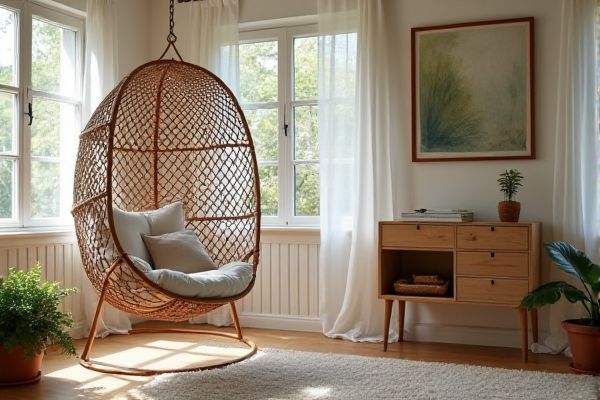
Hammock chairs offer a relaxed, swinging experience with a lightweight design, while hanging egg chairs provide a cozy, enclosed space with sturdy support and stylish aesthetics. Discover how to choose the perfect option to enhance Your outdoor or indoor comfort by reading the full comparison in this article.
Table of Comparison
| Feature | Hammock Chair | Hanging Egg Chair |
|---|---|---|
| Design | Fabric seat, open and flexible hammock style | Enclosed, egg-shaped frame with cushioning |
| Comfort | Lightweight, breathable, ideal for lounging | Plush padding, ergonomic support, cozy seating |
| Materials | Cotton, polyester, or rope fabric | Wicker or rattan frame, cushions with fabric covers |
| Installation | Single hanging point, easy to set up | Requires sturdy frame or stand, often heavier |
| Portability | Lightweight and easy to move | Heavier, less portable |
| Space Requirements | Minimal space, fits small areas | Needs more space due to frame size |
| Price Range | Affordable to mid-range ($50 - $150) | Mid-range to high-end ($150 - $600+) |
| Best Use | Casual outdoor or indoor relaxing | Stylish outdoor or indoor accent seating |
Introduction: Hammock Chair vs Hanging Egg Chair
Hammock chairs provide a lightweight, breathable seating option made from fabric or woven material, offering flexibility and a casual vibe perfect for outdoor or indoor relaxation. Hanging egg chairs feature a sturdy frame with a cozy, cocoon-like shape, often cushioned for added comfort and support, making them ideal for extended lounging sessions. Choosing between these options depends on your space, style preference, and desired comfort level for your relaxation area.
Design and Aesthetics Comparison
Hammock chairs feature a streamlined, bohemian design with a soft, flowing fabric that creates a cozy, relaxed ambiance ideal for casual outdoor or indoor spaces. Hanging egg chairs boast a more structured, modern silhouette with a rounded, basket-like frame, often incorporating rattan or wicker materials that offer a contemporary yet natural aesthetic. Both designs provide unique visual appeal, with hammock chairs emphasizing casual comfort and hanging egg chairs delivering stylish sophistication.
Comfort and Ergonomics
Hammock chairs provide a cocoon-like flexibility that conforms to Your body, offering gentle swaying motion and excellent support for lumbar areas. Hanging egg chairs feature a structured frame with ergonomic curves designed to maintain posture and reduce back strain during extended use. While hammock chairs excel in softness and adaptability, hanging egg chairs prioritize stability and targeted support for enhanced comfort.
Material and Durability
Hammock chairs are typically made from breathable cotton or polyester fabrics, offering comfort but requiring regular maintenance to prevent wear and fading. Hanging egg chairs often feature a durable rattan or resin wicker frame combined with weather-resistant cushions, enhancing outdoor longevity. The sturdy construction of hanging egg chairs generally provides better resistance against environmental elements compared to traditional fabric hammock chairs.
Indoor vs Outdoor Use
Hammock chairs offer versatile indoor and outdoor use, crafted from weather-resistant materials suitable for patios, gardens, or cozy living rooms. Hanging egg chairs are predominantly designed for outdoor spaces, with sturdy frames and cushions that withstand sun and rain, adding a stylish focal point to decks or balconies. Your choice depends on the desired placement and durability needs, as hammock chairs blend well inside while hanging egg chairs excel in outdoor environments.
Installation and Space Requirements
Hammock chairs require a sturdy overhead support such as a ceiling beam or a specially designed stand, demanding moderate ceiling height and secure anchoring for safe installation. Hanging egg chairs often come with their own robust metal frame, making them easier to set up without permanent fixtures and suitable for spaces with limited ceiling support. Both chairs need ample surrounding clearance to allow for swinging motion, but hanging egg chairs typically require more floor space due to their larger frame design.
Maintenance and Care
Hammock chairs require regular cleaning to prevent mold and mildew buildup, usually involving gentle handwashing or machine washing removable covers. Hanging egg chairs often have cushions that need spot cleaning or occasional professional cleaning to maintain fabric integrity and comfort. You can extend the lifespan of both by storing them indoors during harsh weather and inspecting suspension points for wear.
Price and Value for Money
Hammock chairs typically cost less than hanging egg chairs, offering a budget-friendly option without sacrificing comfort. Hanging egg chairs provide a sturdier frame and more elaborate design, which justifies their higher price with enhanced durability and aesthetic appeal. You can expect better long-term value from a hanging egg chair if investing in style and longevity is a priority.
Popular Uses and Placement Ideas
Hammock chairs are ideal for casual relaxation in outdoor patios, sunrooms, or garden nooks, providing a comfortable, suspended seating option perfect for reading or lounging. Hanging egg chairs combine style and comfort, frequently placed on porches or balconies where their enveloping design creates a cozy, private retreat. Your choice depends on whether you prioritize lightweight coziness with a versatile setup or stylish, sculptural seating that adds a statement to your living space.
Which Chair Should You Choose?
Choosing between a hammock chair and a hanging egg chair depends on your space and comfort preferences. Hammock chairs offer a lightweight, breathable design ideal for small areas and casual lounging, while hanging egg chairs provide a more structured, cozy enclosure perfect for reading or napping. Your decision should consider the chair's size, support level, and intended use to enhance relaxation in your chosen spot.
 homyna.com
homyna.com